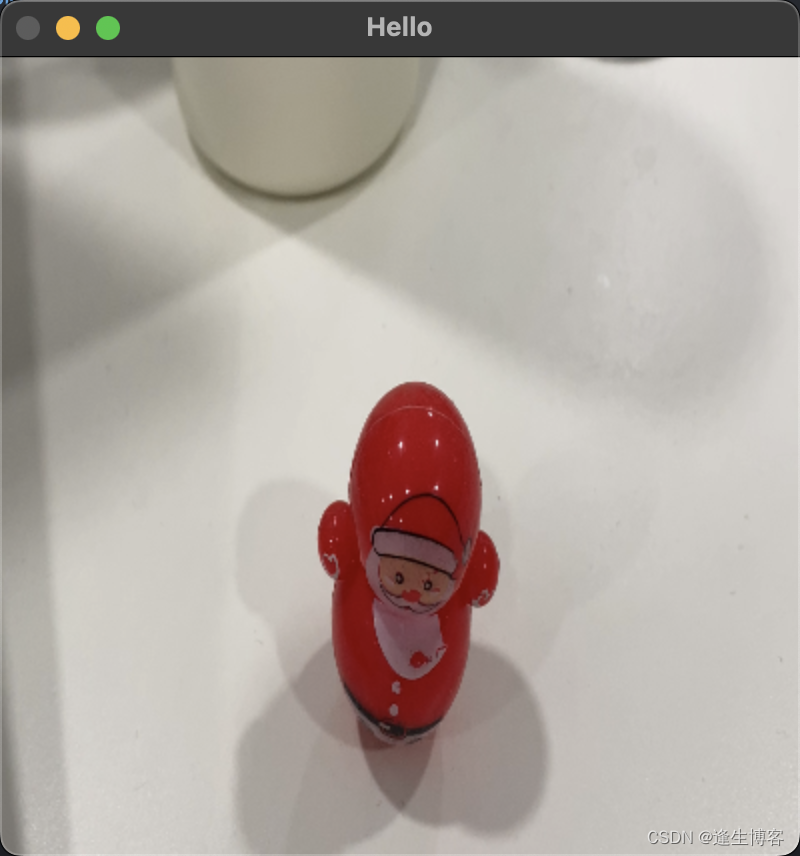文章目录
- OpenCV
- Github
- 官网
- 安装
- 环境变量
- Go的OpenCV绑定库
- Github
- 文档
- 安装
- 搜索视频设备ID
- 显示视频
- 检测人脸
OpenCV
Github
- https://github.com/opencv/opencv/
官网
- https://opencv.org/
安装
brew install opencv
brew upgrade opencv
- 安装目录
cd /usr/local/opt/opencv@4
环境变量
vim ~/.zshrc
export PKG_CONFIG_PATH="/usr/local/opt/opencv@4/lib/pkgconfig:$PKG_CONFIG_PATH"
source ~/.zshrc
- 验证是否安装成功
pkg-config --cflags --libs opencv4

Go的OpenCV绑定库
Github
- https://github.com/hybridgroup/gocv
文档
- https://gocv.io/getting-started/macos/
安装
go get -u -d gocv.io/x/gocv
搜索视频设备ID
brew install ffmpeg
# 列出视频的设备ID
ffmpeg -f avfoundation -list_devices true -i ""

注意: [0] FaceTime HD Camera,deviceID := 0 是电脑摄像头。
显示视频
此示例使用设备“0”打开视频捕获设备,读取帧,并在GUI窗口中显示视频。
# 初始化
go mod init demo
# 安装库
go get -u -d gocv.io/x/gocv
package mainimport ("fmt""github.com/kbinani/screenshot""gocv.io/x/gocv""image"
)func main() {deviceID := 0webcam, _ := gocv.OpenVideoCapture(deviceID)window := gocv.NewWindow("Hello")defer window.Close()// 调整窗口大小winWidth, winHeight := 400, 400window.ResizeWindow(winWidth, winHeight)// 获取屏幕分辨率width, height, _ := getScreenResolution()winX := (width - winWidth) / 2winY := (height - winHeight) / 2window.MoveWindow(winX, winY-100)img := gocv.NewMat()defer img.Close()for {webcam.Read(&img)// 调整图像大小size := image.Point{X: winWidth, Y: winHeight}gocv.Resize(img, &img, size, 0, 0, gocv.InterpolationDefault)window.IMShow(img)window.WaitKey(1)}
}func getScreenResolution() (int, int, error) {// 获取活动显示器的数量numDisplays := screenshot.NumActiveDisplays()if numDisplays <= 0 {panic("no active display found")}// 获取第一个显示器的分辨率bounds := screenshot.GetDisplayBounds(0)width := bounds.Dx()height := bounds.Dy()fmt.Printf("Primary display resolution: %d x %d\n", width, height)return width, height, nil
}

检测人脸
这是一个使用设备“0”打开视频捕获设备的更完整示例。它还使用CascadeClassifier类来加载包含分类器数据的外部数据文件。该程序从视频中获取每一帧,然后使用分类器来检测人脸。如果找到任何人脸,它会在每个人脸周围绘制一个蓝色矩形,然后在输出窗口中显示视频。
haarcascade_frontalface_default.xml 是一个预训练的 Haar 特征分类器,用于人脸检测。它是由 OpenCV 提供的一个经典工具,基于 Viola-Jones 对象检测框架。该文件包含了一系列经过训练的特征,可以快速有效地检测图像中的人脸。
Haar 特征分类器是一种基于机器学习的方法,用于图像中对象的检测。以下是其主要特点:
-
简单矩形特征:Haar 特征由简单的矩形区域组成,这些区域被分成亮和暗部分。通过比较这些区域的亮度差异,可以确定特征的存在。
-
积分图像:为了快速计算矩形特征,使用积分图像(Integral Image)来加速特征计算。这使得检测过程非常高效。
-
级联分类器:级联分类器将多个弱分类器(简单的矩形特征)串联起来,以形成一个强大的分类器。通过逐级过滤非目标区域,逐步缩小检测范围,提高检测速度。
- 下载 haarcascade_frontalface_default.xml 文件
package mainimport ("fmt""github.com/kbinani/screenshot""gocv.io/x/gocv""image""image/color"
)func main() {// set to use a video capture device 0deviceID := 0// open webcamwebcam, err := gocv.OpenVideoCapture(deviceID)if err != nil {fmt.Println(err)return}defer webcam.Close()// open display windowwindow := gocv.NewWindow("Face Detect")defer window.Close()// 调整窗口大小winWidth, winHeight := 400, 400window.ResizeWindow(winWidth, winHeight)// 获取屏幕分辨率width, height, _ := getScreenResolution()winX := (width - winWidth) / 2winY := (height - winHeight) / 2window.MoveWindow(winX, winY-100)// prepare image matriximg := gocv.NewMat()defer img.Close()// color for the rect when faces detectedblue := color.RGBA{0, 0, 255, 0}// load classifier to recognize facesclassifier := gocv.NewCascadeClassifier()defer classifier.Close()if !classifier.Load("./haarcascade_frontalface_default.xml") {fmt.Println("Error reading cascade file: ./haarcascade_frontalface_default.xml")return}fmt.Printf("start reading camera device: %v\n", deviceID)for {if ok := webcam.Read(&img); !ok {fmt.Printf("cannot read device %v\n", deviceID)return}if img.Empty() {continue}// 调整图像大小size := image.Point{X: winWidth, Y: winHeight}gocv.Resize(img, &img, size, 0, 0, gocv.InterpolationDefault)// detect facesrects := classifier.DetectMultiScale(img)fmt.Printf("found %d faces\n", len(rects))// draw a rectangle around each face on the original imagefor _, r := range rects {gocv.Rectangle(&img, r, blue, 3)}// show the image in the window, and wait 1 millisecondwindow.IMShow(img)window.WaitKey(1)}
}func getScreenResolution() (int, int, error) {// 获取活动显示器的数量numDisplays := screenshot.NumActiveDisplays()if numDisplays <= 0 {panic("no active display found")}// 获取第一个显示器的分辨率bounds := screenshot.GetDisplayBounds(0)width := bounds.Dx()height := bounds.Dy()fmt.Printf("Primary display resolution: %d x %d\n", width, height)return width, height, nil
}

![子比主题ACG美化插件[全开源]](http://pic.xiahunao.cn/子比主题ACG美化插件[全开源])

、RTKLIB源码解析 — rnx2rtkp.c)
从零基础入门到精通)


)








)



